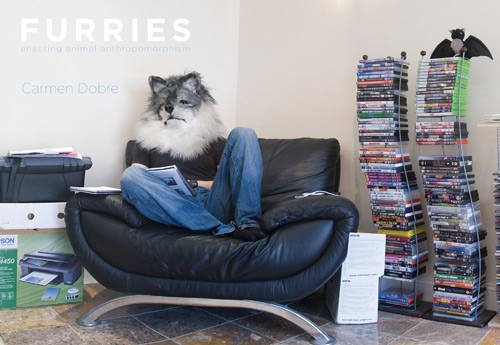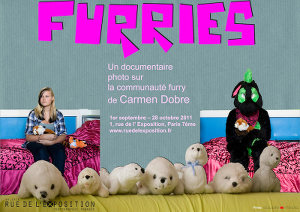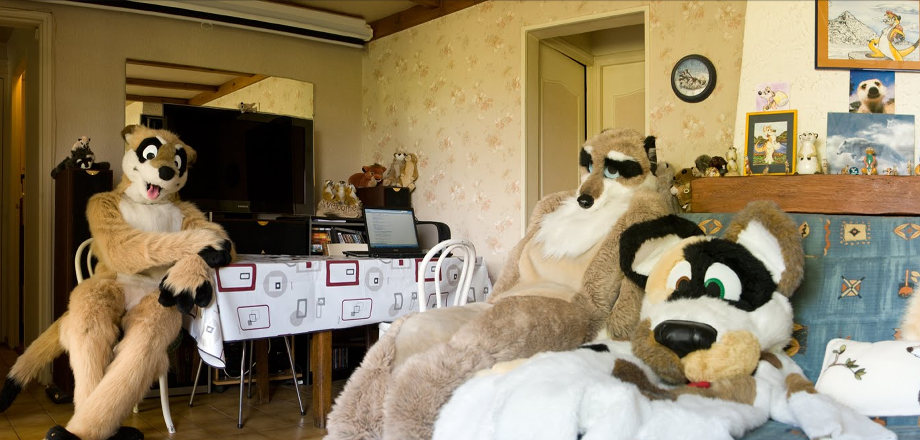Photographer Carmen Dobre seeks insights into furries via 360° home panoramas
If you were waiting for a coffee-table book mixing fursuiting and cultural research, Furries: Enacting Animal Anthropomorphism might be it. It was created by Romanian Carmen Dobre, a Master in both cultural studies (Univ. of Bucharest) and photographic studies (Leiden), who is pursuing a PhD at the Bucharest National University of Arts. [tip: Dr. Kathy Gerbasi]

The 152 page hardback contains 49 photographs, 13 of which can be previewed online (scroll in for a full view). Produced by the University of Plymouth, it's also available from eBay UK or Australia, Amazon U.S. or Canada, Albris, and Fishpond.
Carmen's furry photography began in Holland as a university project, and spread to France, Romania, Germany, and the UK (assisted by Fotonow CIC). Her work was exhibited September-October 2011 (video) at the Rue de l'Exposition gallery. One photo was a finalist for the 2013 Celeste Prize. She has also created a brief study of furry fandom (PDF).
Carmen explained her method while recruiting subjects on FranceFurs; she also visited UKFur.org and FurBase.de [both free registration required]:
Shoots vary in relation to how much the subject can give me. There are locations where I can try several shots and locations which allow fewer options. A typical shoot is 3 hours or so. I also have an interview taken with questions such as: why did you choose this fursona, is being a furry a matter of identity for you, have you been discriminated etc. [… when taking 360° panoramas:] I mount the camera on the tripod and take around 70 separate shots which I then stitch in photoshop. therefore the subject has to pose in front of the camera and is at all times aware of what I'm doing. I generally don't give indications, and don't stage anything.
Interviewed in Romania's Suplimentul de Cultura (translation), Carmen proposed that furries represented a Western tend of self-reinvention; and that, while globalization had brought economic changes to Eastern Europe faster than cultural ones, furry would spread rapidly via the Internet.
The book's blurb gives a good idea of what readers will get, albeit focussing on the fursuits:
Award winning photographer Carmen Dobre continues her examination of 'furries', who they are and how they perceive themselves.
Documentary style portraits alongside one-to-one interviews reveal the intriguing passions of people whose human identity is challenged by their love of their chosen animal persona/fursona.
The first colour illustrated book featuring an international cross-section of individuals who choose to dress as animals and why.
Some might be concerned by Book News's summary, which describes furry as:
[…] a fetish community whose members identify themselves as animals, or else are uncomfortable in their human bodies as humans and wear full-body "fur-suits" to express this.
After introducing the culture, most of the book showcases several furries, both male and female, living across Western Europe. These cases consist of an interview describing their motivations, their experiences as furries in a world of non-furries, and their views on the community particularly in light of the Internet. The photographs are somewhat random shots of the furries' homes, but usually feature the furry themselves in their suit and out of their suit.
Carmen offers a more nuanced description in an 2010 blog post:
The individuals featured in the photographs are part of an international community which is called furries and which relies on the idea of identifying oneself with an animal figure of choice. The result of this identification is a character sharing both animal and human features and being called fursona. In many cases the fursona manifests itself as an animal costume (fursuit) which the respective community member wears in the privacy of his/her home or in public. In a few instances the fursuit functions as a sexual fetish, case in which is it denominated as mersuit. [sic.]
Carmen also covered her reason for using 360° photography:
In the submitted images, the costumed subject is integrated in the wide field of the panorama and consequently the viewer perceives him/her as part of a spatial continuum of various ordinary objects such as household items, buildings or cars. Consequently, in this everyday environment the person wearing a fursuit appears even more striking than a portrait or a narrow shot would allow.
In this way the comparison between standards of normality and this identity difference is in my opinion heightened.
Read more: Fred Patten reviews Furries: Enacting Animal Anthropomorphism

About the author
GreenReaper (Laurence Parry) — read stories — contact (login required)a developer, editor and Kai Norn from London, United Kingdom, interested in wikis and computers
Small fuzzy creature who likes cheese & carrots. Founder of WikiFur, lead admin of Inkbunny, and Editor-in-Chief of Flayrah.


Comments
Good for her! But where'd she find enough furries in Romania? Especially fursuiters?
If you read the third paragraph, you will see that her project did not begin or end in Romania.
In case it is unclear, Carmen is not furry herself, as she mentions in the linked interview:
I get that. But she said it passed through Romania as well. Which means she found some case studies here as well. And this is what I'm curious about.
I have a review of this book, sent in last November 22. It hasn't been posted yet.
Dobre identifies the Fursuiters whom she interviewed as living in Britain, France, Germany, and the Netherlands. She credits universities and art institutes in Romania as funding her research, but none of it was done there.
Fred Patten
Then I'm misreading the article. Oh well.
Dobre does say that, but I assume that whatever she did in Romania was in the nature of correlating her interviews into a whole and writing the text for this book. Her interviews all take place in what I would call northwestern Europe; London, Rotterdam, Hamburg, etc. I think that the farthest south she goes is Paris.
Fred Patten
I think she gives a fantastic reason for choice of format. It's concise and makes sense without art-jargon.
Photographing fursuiters well seems like a hard challenge! Dance is a good occasion for it. Parties and crowded clubs can be, especially with colored lighting that helps unify them. Outdoors in nature can make nice setting contrast. Street suiting makes nice reaction shots. But many other occasions I have seen make fursuiters appear static and lifeless (unposed hotel shot after shot), or a disorganized barf of too many clashing colors (fursuit parades) that doesnt make a pleasing photo. I like the bottom shot here and think the panorama does what she says. Good for her. I'd love to hear other photographers opinions about the art of shooting fursuiters.
Finally something we can agree on. You did forget one the stat arm extended jazz hand shots.
The challenge is how can I avoid such shots at a con.
Post new comment